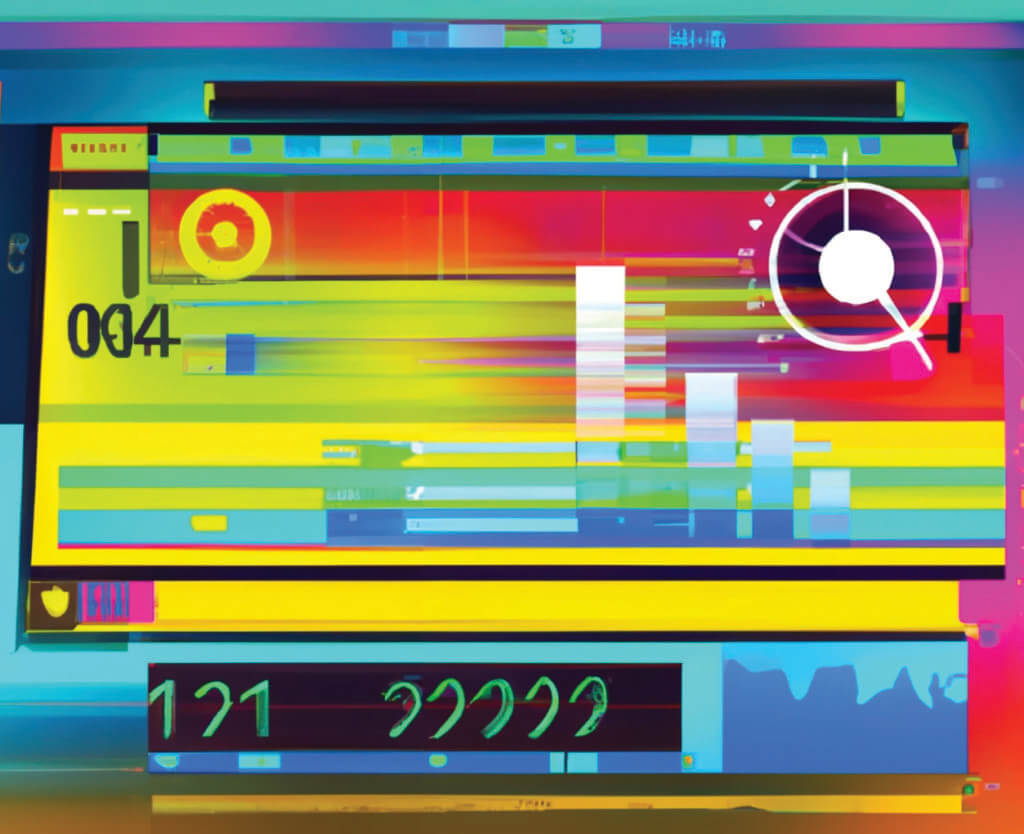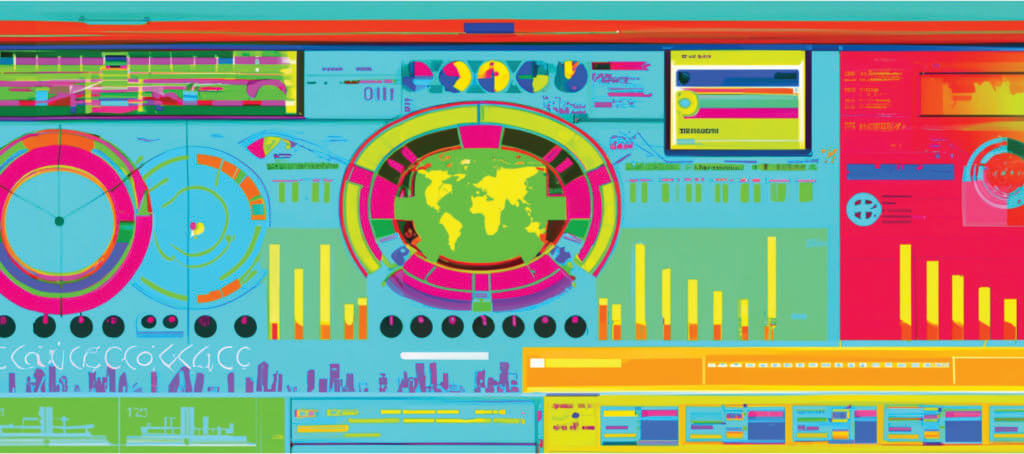 Insight Arjen Groeneveld on how psychological principles help people make better decisions when interacting with data
Insight Arjen Groeneveld on how psychological principles help people make better decisions when interacting with data
Many principles and best practices shared by experts have stood the test of time. What makes these guidelines so enduring, and why are they universally accepted? Arjen argues that it all boils down to understanding psychological principles.

This image was created with the assistance of DALL·E 2
If you work in data, you’ll no doubt be familiar with attention-grabbing headline like this one:
“Follow these 10 rules on how to improve your data dashboard, make it stand out from the rest, and communicate your data more effectively…”
Often with these how-to lists, I’m more interested in the ‘why’ behind the tips and tricks on offer. More specifically, I’ll end up looking into the psychological principles at the core of a better-performing piece of data design (in this case, a data dashboard).
I studied social psychology and wrote my master’s thesis on rational decision-making and heuristics. Although this was a while ago, insights from these fields are still relevant even after I’ve worked in market research and data visualisation for 15 years. In fact, studying how we interact with an overwhelming amount of information on a daily basis has only become more relevant today.
So why should a dashboard be uncluttered, have a few large numbers (BANs) at the top, tell a clear story, and offer at least some additional insight or interactivity? The answers lie in how we make decisions.
Humans are not rational. Design can never be neutral.
In my experience, the following two psychological principles are the most important to consider when making data dashboards:
- People are not rational decision-makers
We often make decisions while we’re distracted or pressed for time, with limited information available. That’s why we use rules-of-thumb or heuristics. These mental shortcuts can be helpful, but they can often lead to systematic biases, especially when dealing with numbers. - There is no such thing as neutral design
Everybody who designs a data dashboard is consciously or unconsciously affecting the subsequent human behaviour or decision-making. Just consider how someone who sets up a data dashboard deliberately focuses our attention in a certain direction. As a result, we are all “choice architects”.
In this article, I’ll further explore these two principles and their impact on developing data dashboards, as well as other types of data visualisation.
Relying on heuristics to make decisions

This image was created with the assistance of DALL·E 2
Even though we think of ourselves as rational decision-makers, we usually are not. We base our decisions on emotions, unrelated information, experience, and simple rules-of-thumb that have helped us in previous cases.
When we’re pressed for time, dealing with limited attention, or overwhelmed by the amount of information, we use mental shortcuts to respond to the complex world around us. Although these mental shortcuts (aka heuristics) can be helpful in making quick decisions, they can also lead to systematic biases.
Heuristic #1: The framing effect
One of my favourite examples of heuristics is the framing effect.
Consider the following two statements:
- The odds of survival one month after surgery are 90%.
- Mortality within one month after surgery is 10%.
The first statement is obviously much more attractive than the second one. If a doctor wanted to explain these odds to you, she would wisely choose the first. However, these statements reflect the same odds. And yet people will react very differently to them, and perhaps they would not even choose the surgery after hearing the second statement.
Even in this simple example, we tend to use heuristics to make decisions based on data. We are not intuitive statisticians, meaning we don’t have a natural grasp of statistics. Dealing with random numbers, chance, risk and probability is difficult and requires deliberate thinking, so we often fall back on rules-of-thumb. Even trained and experienced statisticians use them.
The perils of system 1 thinking: What you see is all there is
To dive deeper into the psychology of decision-making and heuristics, we need to look at the two systems of the mind: system 1 and system 2 thinking.
- System 1 operates automatically and quickly with little or no effort and has no sense of voluntary control.
- System 2 allocates attention to the effortful mental activities that demand it, including complex computations.
System 1 thinking can be viewed as our fast-acting and impulsive ‘lizard brain’. It will make quick first impressions when we are distracted and will try to override our system 2 thinking. It will not look further than what we directly perceive: What you see is all there is. This is what happens in the framing effect – we tend to see only what is directly in front of us.
Heuristic #2: The anchor effect
Another process that happens in our fast-acting system 1 is the anchor effect. When asked, for example, whether Gandhi was more than 114 years old when he died, people often provide a much higher estimate of his age at death than when the question was asked if he was more than 35 years old when he died. How we anchor the question influences the value that we end up with.
Anchoring influences our estimation of numbers. A low or high number can anchor us to a value to which subsequently too little is adjusted. Even obviously unimportant and unrelated numbers can influence people’s judgments in this way.
Heuristic #3: Representativeness
The representativeness heuristic plays a role when working with probability and chance. Let’s take the Gambler’s fallacy as an illustrative example.
We expect that a number of coin tosses will roughly result in an equal outcome of heads and tails. As such, a sequence of HHTHTT may be seen as more probable than HHHHTH. In reality, however, the coin will not magically adjust its outcome to tails just because it was preceded by a long sequence of heads.
We tend to see patterns in random numbers because our system 2 thinking does not like it when there is an unordered and meaningless bunch of digits. The concept of randomness is difficult to grasp, and even if we know something happens by chance, we tend to look for patterns. And, sometimes, we even find them.
Heuristic #4: Availability
After a storm has passed, causing flooded streets and damage to cars, houses and trees, insurance companies know they will be selling more insurance policies against natural disasters. This is called the availability heuristic – the process of judging frequency by the ease with which the instances come to mind.
This mental shortcut also explains why we see correlation between variables when there is no real relationship in the data. If an explanation for why things would be related is simple and easily retrieved, this will be perceived as the truth. Not only do we look for patterns that are not there, we also tend to find explanations that come to mind more easily.
We use many other mental shortcuts or rules-of-thumb when looking at data, and many systematic cognitive biases and fallacies are based on them. So we can expect these heuristics to play a role in how we interact with data in a dashboard. Armed with this knowledge, how do we mitigate such errors?
The art of choice architecture

This image was created with the assistance of DALL·E 2
We’ve seen that interacting with data is not as straightforward as we might think. We’re all busy people trying to make sense of the complexity around us, and we have shorter attention spans because of the constant feed of information coming towards us. As a result, we often cannot afford to think deeply about the choices we need to make.
When looking at data in a dashboard, the same rules-of-thumb are applied. A data dashboard typically presents multiple data sources: sales numbers next to marketing spend, revenue and costs, for example. Our attention is divided over several pieces of information, and we are trying to form a coherent picture. At the same time, visual complexity forces our automatic system 1 thinking to form rapid insights and override the more thoughtful system 2.
As we design our dashboards, then, we inevitably direct our user’s attention and indirectly influence their decision-making. We are choice architects, and since our data dashboard will be used by human decision-makers, it should reflect a good understanding of how humans make decisions.
Designing with cognitive biases in mind: 4 key factors
Humans make mistakes. A well-designed data dashboard should take this reality into account. Interactive dashboards have the unique opportunity to guide users step-by-step so that they are not overwhelmed with information. At the same time, users must often face a strong “what you see is all there is” force, leading them to make decisions based on availability, anchors and similarities (representativeness).
Is awareness of these cognitive biases enough to stop us from making these errors? Probably not: Our system 1 vs. system 2 data processing is strong and well-established. However, we should be designing with this understanding in mind.
1. Unclutter to decrease cognitive overload
This tip is probably the number one in how to design an effective data dashboard. And, yes, it often looks better and cleaner when the data presented has some breathing space. But shouldn’t you just want to show all the data at once and have users figure things out for themselves? Certainly, clients often ask for a data dashboard that has everything in it.
Although this may seem like a good idea, it is not advised. Environmental complexity has been linked to decreased effectiveness of decision-making. On the other hand, there should be enough information complexity to trigger people to investigate more.
2. Offer considered mappings and structure
Two strategies that will help people better navigate a dashboard are by providing mappings and structuring complex choices. A mapping serves to make the information more comprehensible, for example, by showing how certain values are calculated or by making clear how certain information is structured.
3. Use defaults wisely
Especially in cases where information is scarce, humans have a behavioural tendency towards doing nothing (the status quo bias). We will look at the data that is directly available to us and what is activated in our brain as a result, but not at what we cannot see. We’ll then be fast in forming a story, and the amount and quality of the information used are largely irrelevant.
The information that is shown is seen as the default option and as pre-selected for a reason. Just as with choosing a payment plan for some online service, this default is pre-selected for us, but it is not necessarily the best option (for us).
By letting users select their own defaults, we invite them to look further and engage with the data, and we eliminate any possible anchoring effects.
4. Give clear UI feedback
The best way to help people make good data-based decisions is to provide clear UI feedback.
Feedback tells us where we are and which choices have been selected. A well-designed data dashboard, for example, shows the filters that we have selected and motivates us to interact with the data and to see those connections that lead to meaningful insights.

This image was created with the assistance of DALL·E 2
The best data dashboards are those that show you what you need to know and give you enough possibilities to dig deeper and uncover additional insights. This process of discovery is made possible by providing structure, mapping and feedback (among other things), and by taking into account that we can be misguided by the many rules-of-thumb on which we like to call.
As dashboard designers, we have a duty to present data in the most truthful and helpful way possible, nudging our users’ reflective system (system 2) to analyse the data and make better, smarter decisions, rather than being taken over by our automatic system 1 thinking.

Suggested further reading
- Nudge: Improving Decisions About Health, Wealth, and Happiness, 2008. R. H. Thaler and C. R. Sunstein
- Thinking, Fast and Slow, 2011. Daniel Kahneman
- The design of everyday things, 2013. Don Norman
Images
The images in this article were created with the assistance of DALL·E 2 using the prompt “Multi coloured abstract futuristic data dashboard”. DALL E was repeatedly asked to iterate on the previous image it made, creating a whole sequence as shown above and throughout this article.
As Arjen has shared, designing a data dashboard that is useful to users requires a good grasp of psychological principles. Although it may be overwhelming to take all of these considerations into account, we’re here to help. At infogr8, we join the dots so you can do more with data. Send us a message to find out more.
About Arjen Groeneveld

Arjen Groeneveld is a data visualisation and information designer based in Amsterdam. He has a background in social psychology, data analytics, and market research. He currently works for FCB Health NY, where he focuses on bringing data to life in impactful and understandable visuals.
